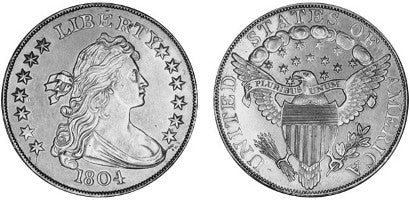5. 1804 Class III silver dollar
 Eckfeldt's attempt at recreating the illustrious Bowed Liberty Dollar |
These dollars were struck illegally by US Mint worker Theodore Eckfeldt between 1858 and 1860 in an attempt to sell counterfeit copies of the illustrious Class I silver dollar to coin dealers.
The die used to strike the coins was eventually seized by the mint's director James Ross Snowden, though some of Eckfeldt's fakes had already been purchased by eager collectors.
Only seven examples of the coin are known to exist today, most of which are housed in museums. The last to appear was the Adams-Carter Specimen, which brought an impressive $2.3m to Heritage Auctions in 2009.
4. 1804 Class I silver dollar (Bowed Liberty Dollar)
 The Class I is the coin given to Anna in The King and I |
The coins that Theodore Eckfeldt attempted to replicate were minted in 1834, after the 19,750 silver dollars produced in 1804 were struck using the old 1803 dies in order to save money. The Class I coins were struck later as gifts for Asian rulers in exchange for trade advantages, with one presented to Rama III, king of Siam and another to Said bin Sultan, sultan of Muscat and Oman.
Who the remaining five were given to remains a mystery, after ambassador Edmund Roberts died during the voyage. The example given to the king of Siam, which was once displayed in the Smithsonian Institution, was sold for $4.14m in 2001.
3. SS Central America gold ingots
 Just one of hundreds of Kellogg & Humbert ingots discovered on board |
OK, so they aren't actually coins, but one of these ingots (weighing 80 pounds) became the world's most valuable piece of currency at the time, when it sold for over $8m. It was discovered on the wreckage of the SS Central America - also known as the Ship of Gold - back in 1987, where it had lain since the ship was sank by a hurricane in 1857.
The total value of the recovered gold and coins aboard the ship was estimated at $100-150m, and the array of rarities discovered have been appearing at auction ever since. Bonhams will sell a 40 ounce gold ingot on September 2, while the Pueblo Collection of US Gold Coins - which focuses on the SS Central America find - will star at the ANA World's Fair of Money auctions, beginning August 4.
2. 1787 Brasher Doubloon
 The one-time record holding coin was created outside of the US Mint |
The Brasher Doubloon came about as a result of Ephraim Brasher's petition to the State of New York to begin minting copper coins. His petition was rejected by the state, so Brasher - a respected goldsmith and assayer - decided to strike his own coins, producing a range of coppers and a small amount of gold examples.
Made with 22-carat gold and weighing 26.6 grams, the unique New York Style EB Punch on Breast Brasher Doubloon sold for $2.99m at Heritage Auctions in 2005. However, it was resold in a private treaty in 2011 to a Wall Street investment firm, who paid a then-record price of $7.4m.
1. Saint Gaudens Double Eagle
 The most beautiful and valuable US coin in history |
The $20 coin, created by the respected Irish-born sculptor Augustus Saint Gaudens in 1907, is widely regarded as the most beautiful coin in American numismatics. Created to emulate those used in ancient Greece at the behest of President Theodore Roosevelt, the coin's initial ultra-high relief design caused problems for the US mint and low-relief versions had to be issued for circulation.
One of these low-relief versions, from the last year of circulation in 1933, sold for $7.59m in 2002 at Sotheby's, topping the record previously held by the Brasher Doubloon to become the most valuable rare coin ever sold at auction.
Paul Fraser Collectibles has a fantastic range of investment-grade rare coins currently on offer. For more great articles from the numismatics world, visit our dedicated coins & banknotes news section.






